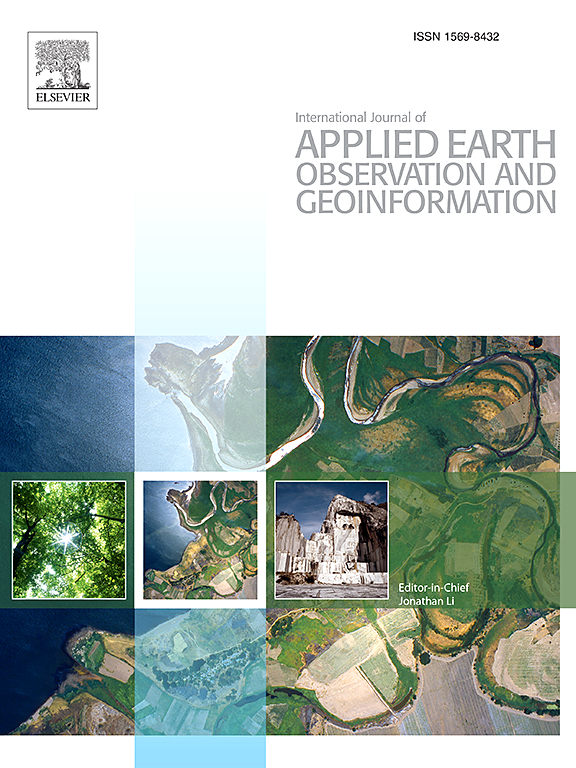优化作物类型映射的公平性
IF 8.6
Q1 REMOTE SENSING
International journal of applied earth observation and geoinformation : ITC journal
Pub Date : 2025-06-21
DOI:10.1016/j.jag.2025.104672
引用次数: 0
摘要
确保机器学习应用程序的公平性至关重要,但在作物类型映射方面仍未得到充分探索。虽然地球观测领域已经知道监督分类任务中不平衡类别的后果,但评估社会敏感属性子群体的分类结果,例如作物制图中的地块大小,却很少受到关注。为了解决这一差距,我们评估了现有的类失衡校正方法:随机过采样(RO)、加权交叉熵(WCE)和焦点损失(FL);以及两种针对类别不平衡和大小包裹之间性能差异的新方法:随机过采样与重采样(RO-R)和双目标加权交叉熵(DOWCE)。RO-R通过重新分配随机样本来增加小包裹的表示,而DOWCE对小包裹的错误分类施加更高的惩罚。混合方法(RO-DOWCE和RO-FL)也进行了评价。为了评估这些方法在不同条件下的可泛化性,我们在覆盖法国布列塔尼的BreizhCrops数据集的10个不同数据集上进行了测试。结果表明,RO- dowce是解决数据集类别不平衡的最有效方法,尽管与RO- r、RO和RO- fl没有显著差异。此外,与样本平衡和混合方法相比,成本敏感方法在处理类不平衡方面通常效率较低。这些发现表明,关于负责任的人工智能和公平性的更广泛讨论与作物类型测绘等地球观测应用相关。此外,本文提出的提高公平性的策略可以应用于作物映射领域之外的分类任务。本文章由计算机程序翻译,如有差异,请以英文原文为准。
Optimizing crop type mapping for fairness
Ensuring fairness in machine learning applications is critical, yet it remains underexplored in crop type mapping. While the consequences of imbalanced classes for supervised classification tasks are known to the field of Earth Observation, assessing classification results for sub-groups of societally sensitive attributes, such as parcel size in crop mapping, have received little attention. To address this gap, we evaluate established class imbalance correction methods: Random Oversampling (RO), Weighted Cross Entropy (WCE), and Focal Loss (FL); and two novel approaches that target both class imbalance and the performance disparity between small and large parcels: Random Oversampling with Resampling (RO-R), and Double Objective Weighted Cross Entropy (DOWCE). RO-R increases the representation of smaller parcels by redistributing random samples, whereas DOWCE applies higher penalties to the misclassification of smaller parcels. Hybrid methods (RO-DOWCE and RO-FL) were also evaluated. To assess their generalizability under varying conditions, the methods were tested on ten diverse datasets subsampled from the BreizhCrops dataset, covering Brittany, France. Results showed that RO-DOWCE was the most effective method at addressing class imbalance across the datasets, though not significantly different from RO-R, RO, and RO-FL. Additionally, cost-sensitive methods were generally less efficient at addressing class imbalance than sample balancing and hybrid approaches. These findings illustrate how broader discussions on Responsible AI and fairness are relevant for Earth Observation applications such as crop type mapping. Furthermore, the strategies to increase fairness presented here can be applied to classification tasks outside the domain of crop mapping.
求助全文
通过发布文献求助,成功后即可免费获取论文全文。
去求助
来源期刊

International journal of applied earth observation and geoinformation : ITC journal
Global and Planetary Change, Management, Monitoring, Policy and Law, Earth-Surface Processes, Computers in Earth Sciences
CiteScore
12.00
自引率
0.00%
发文量
0
审稿时长
77 days
期刊介绍:
The International Journal of Applied Earth Observation and Geoinformation publishes original papers that utilize earth observation data for natural resource and environmental inventory and management. These data primarily originate from remote sensing platforms, including satellites and aircraft, supplemented by surface and subsurface measurements. Addressing natural resources such as forests, agricultural land, soils, and water, as well as environmental concerns like biodiversity, land degradation, and hazards, the journal explores conceptual and data-driven approaches. It covers geoinformation themes like capturing, databasing, visualization, interpretation, data quality, and spatial uncertainty.
 求助内容:
求助内容: 应助结果提醒方式:
应助结果提醒方式:


